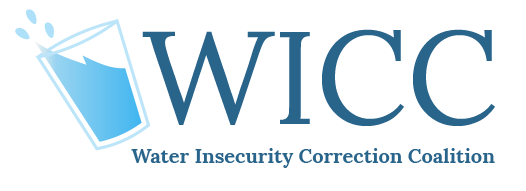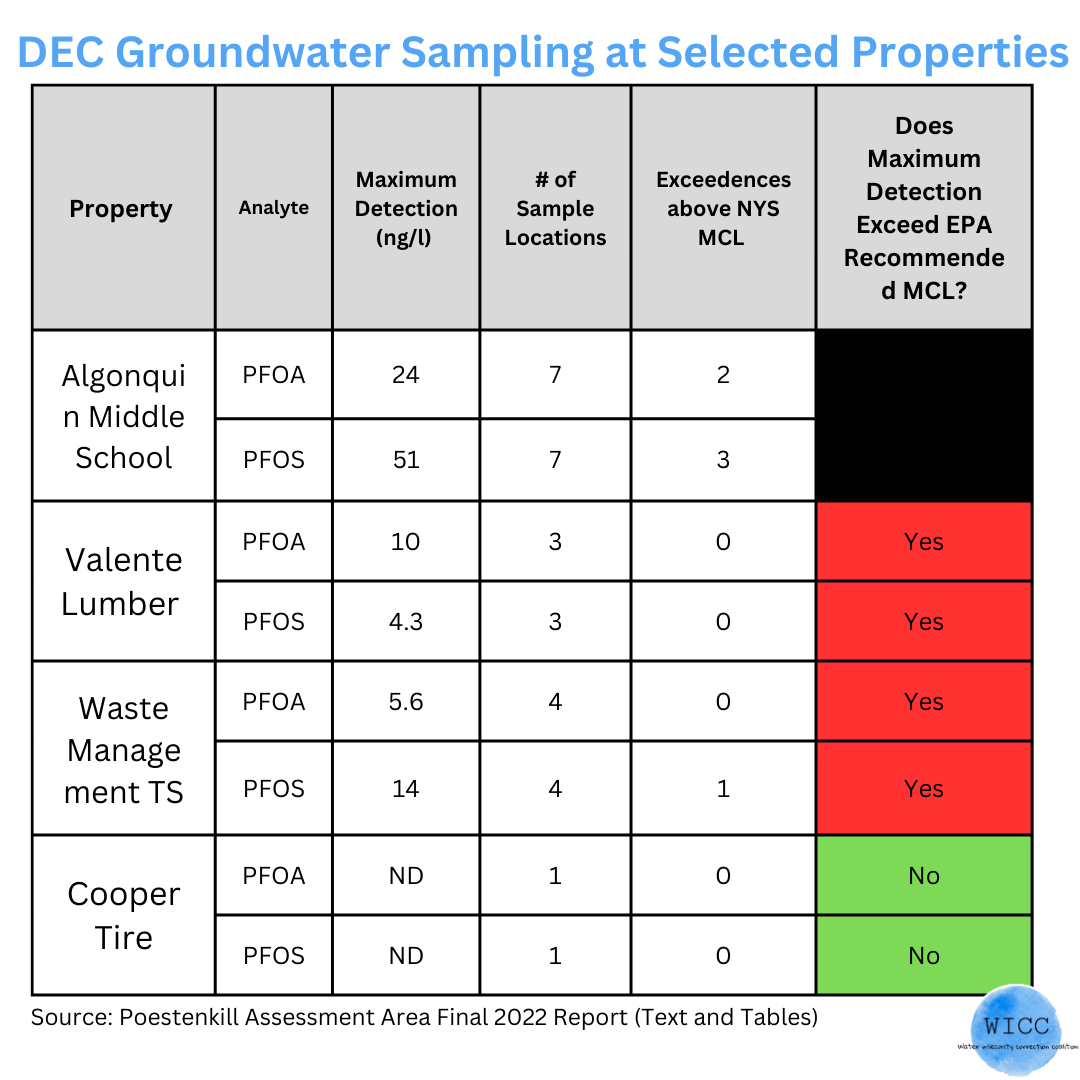POESTENKILL — On Wednesday, June 28th, WICC invited residents of Poestenkill to listen and participate in a conversation about the PFAS contamination of the town's water supply. UWCP Project Lead and WICC Founder, Annabel Gregg, started the event with an overview of the PFAS problem history and updates on proposed solutions for the town. Panelists representing key state agencies like DEC and DOH as well as Town figureheads fielded questions from WICC and the audience.
As an issue that started in January 2021 after high levels of PFOA were discovered in Algonquin Middle School’s water, efforts to understand and remediate the problem have been in the works for more than two years. This past spring, the NYS Department of Environmental Conservation (DEC) released its report touting the conclusion that no evidence pointed to a major point source of the contamination. The Town of Poestenkill has proposed a new water district that would connect residents surrounding Algonquin Middle to the Tomhannock Reservoir in Troy, NY.
Panelists
Eric Wohlleber - Deputy Town Supervisor and Councilman, Town of Poestenkill
Rich Elder - Environmental Health Director, Rensselaer County Department of Health
Tony Bollasina - Project Manager - New York State Department of Environmental Conservation
Justin Deming - Chief, Regions 4, 5 & 8, Bureau of Environmental Exposure Investigation, New York State Department of Health
Greg Pattenaude - Representative, Concerned Citizens for Clean Drinking Water
Q: Is there a specific expiration date for the grants?
A (E.W.): The state grant expiration date is in 4 years.
Q: After attending the State Drinking Water Quality Council Meeting, NYS agencies have determined that PFOS and PFAs are likely carcinogenic, among other harms. Can anyone speak to that or the meeting?
A (J.D.): EPA is using hazard quotients to determine limits for drinking water quality standards. The full meeting can be referenced and found at this link - https://totalwebcasting.com/view/?func=VOFF&id=nysdoh&date=2023-06-28&seq=1
Q: Algonquin Middle School is included in the cost of the proposed water distinct #2. Because the MS is the property of school district taxpayers, not just town taxpayers, will all taxpayers in the school district pay for the cost of the school to be added in the water district #2?
A (E.W., G.P., and Eric, resident): If the approval of the water district #2 were put to a community vote, Algonquin Middle School would get a single vote. In the creation of the water district #2, costs would be the responsibility of the school. Therefore, all taxpayers in the school district would bear the cost, and arguably all taxpayers in the state. However, the cost to the school would be 30 times higher than a single household’s cost, given the number of connections.
Q: The conclusion in the DEC report is that there is no known source. What does that mean in regard to qualifying for a Superfund money? Is it possible to tap into Superfund support given the multiple sites with high contamination levels?
A (T.B.): A site that is usually given Superfund money would be one that has a source that the DEC could remedy. A source would be qualified as being found through multiple media at elevated levels, spatially associated with each other, and tied to an obvious cause (leaking barrel, firefighting foam sites, etc.). The ubiquitous use of these compounds (PFAS) in everyday consumer lives has led to low levels of detection due to discharge at the surface. This is why supply chain management and well water testing is so important.
Q: That same conclusion means that the combination of geology and domestic wastewater leachate have the potential to contaminate well water systems in almost any location, not just Poestenkill.
A (T.B.): The attribution of domestic wastewater to low-level PFAs contamination is being investigated in several areas throughout the state.
A (J.D.): Septic systems are historically designed to deal with bacterial waste, which breaks down. These chemicals don’t break down, so it is expected that they would persist, even with small amounts of leachate. Thereby affecting wells that may be nearby. Here is a link to a fact sheet for reducing PFAS in private wells: https://www.dec.ny.gov/docs/remediation_hudson_pdf/pfasprivatewellsfs.pdf
Q: Given all of the variables that you mentioned about this case, including geology, is Poestenkill unique?
A (T.B. & J.D.): The geology of Poestenkill is not representative of the state, so in that respect, it is unique. The other factors, such as private well and septic systems, are not so unique in the state. Other states such as Vermont and New Hampshire do have similar geology to Poestenkill, and are experiencing similar problems. The three states are working together to come up with possible solutions.
Q: Is there anything that residents should take into consideration about the depth of their wells?
A (T.B.): Although the state cannot make any recommendations because they do not regulate private wells, a deeper well and deeper casing might avoid contaminated water. However, that may not be economically beneficial given the low levels of contamination. Spending hundreds of dollars on filters versus thousands on putting in new wells is the decision homeowners face in that respect. However, PFAs grab onto carbon, making activated carbon filters especially effective for low levels of contamination. Public water is also a great option, given the geology of the town.
For those curious about how geology affects the water quality: https://pubs.usgs.gov/sir/2008/5087/pdf/SIR2008-5087.pdf
Q: Would the water coming in from the Tomhannock Reservoir be filtered?
A (A.G. and R.E.): The water would be treated before it gets to the service lines. The city of Troy has its own filtration plant, and as the water travels to Poestenkill, it goes through multiple re-chlorination stations.
Q: Do those filters include carbon or other filters that filter out PFOAs?
A (R.E.): The city does have the ability to put in carbon beds for that purpose, but have not done so because there has not been a need. The water at the reservoir gets tested quarterly, and there have been extremely low or no levels of PFAs detected. Any detections of PFAs were so low that they could be attributed to lab or sampling error.
Q: Is it safe to assume that detection levels are going to rise based on the amount of time it takes for these chemicals to leach through soil?
A(T.B.): If the levels in the discharge point remain the same, then yes the levels would be expected to rise. Given the fact that manufacturers are removing PFAs from the supply chain, the amount of chemicals in the discharge point should decrease. Due to this, as well as water diffusion and dilution, the detection levels would be expected to decrease over time.
Q: Are there any plans for ongoing testing of surface water?
A: No panelists were able to answer this question
Q: Were PFAS levels higher in the past? This is a worry because of the public health affects and unknowns involved with PFAs.
A(J.D.): There is no way to get historic water quality data. Toxicologists at the DOH don’t believe that the drinking water exposure to PFAs at these levels would result in detection of contaminated blood.
A (A.G.): If anyone is personally concerned about this, given the bioaccumulative nature of these chemicals, a blood test would be the best way to learn if you’ve been exposed over long periods of time.
A (E.W.): Having the Town pay for water tests and extending the current water district are both options that have been brought up to the Town Board, but have not gained any traction.
Q: Are the $70 tests that WICC can acquire for residents comparable to the $350 ones that some residents have used before?
A (A.G.): The tests likely use the same analyte method for detection, however the Cyclopure tests are not certified. These would not be able to be used in a court of law, although they are good for residents that are curious about their own water.
The full recording of the town hall, including the presentation can be found at www.yeswicc.com/poestenkill.












